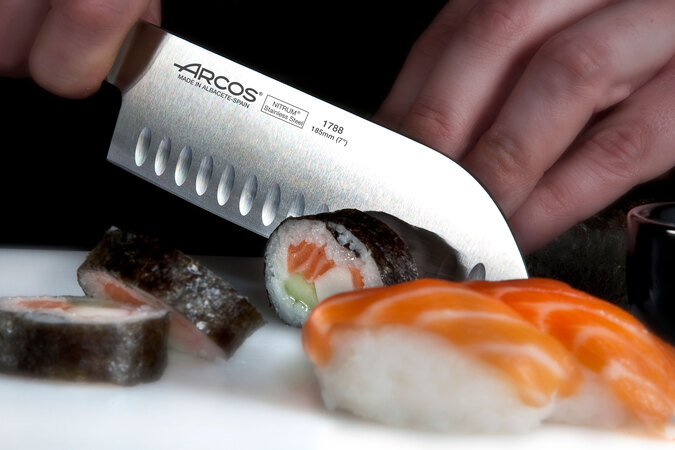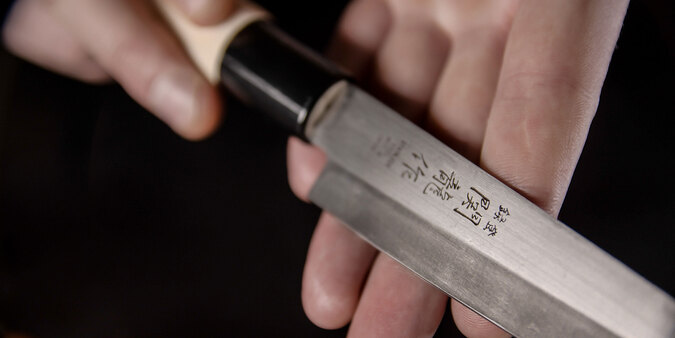Purchasing high-quality kitchen utensils and accessories can greatly facilitate the process of cooking, which can easily turn into torture without the right knife.
Due to the large selection of varieties and models in this segment, it is easy to get confused, so you need to know exactly the purpose of each kitchen knife. In this article we will talk about ways to use knives in the kitchen and suggest several options from the Complex-Bar range.
Chef's knife or utility knife
This is a multi-functional knife, a must-have tool in any kitchen. The universal knife is designed for rough peeling and slicing of almost all possible products: from vegetables to meat, and is also suitable for quickly serving snacks. It is he who does the bulk of the work in the average home kitchen. However, if more complex and delicate work is required, such as filleting fish, special types of knives with a unique anatomy are needed.
You will find a wide selection of such knives in the “Classic” series from the Arcos brand, and if you are a lover of natural materials, then you will certainly appreciate the chef’s knives in the recently released “Nordika” collection.
Chef's knife
It's such a versatile tool that some chefs make do with it exclusively. This knife is especially well suited for chopping, because this is what takes up most of the time of professional chefs. The length of the blade can be 15-30 cm, but the most optimal size is 25 cm. The chef's knife has a long triangular curved blade, which allows you to swing the tool when slicing, which significantly speeds up the cooking process.
The handle factor is very important here: it must fit perfectly in the hand, so an individual approach is required for each cook. For those who like flexibility, knives with polypropylene handles are suitable, and for those who need hardness, knives from the Japanese brand Sekiryu, Osaka series, are suitable.
bread knife
The main feature of knives of this type is a serrated (serrated) blade, with which you can easily cut a hard bread crust without damaging the pulp, and a rounded tip. When choosing a bread knife, you should pay attention to the length of the blade. It needs to be at least 25 cm. The longer the blade, the more useful it will be, but especially large knives require a spacious workspace.
In this category, the unusual new product from Kasumi is especially interesting, but classic options are presented in a wide range from the Arcos and Prohotel brands.
Santoku
From Japanese, “santoku” is translated as “three virtues,” which means its suitability for three types of work: cutting, chopping and shredding. This knife has a wide blade with a rounded spine and a straight edge. The center of gravity is shifted to the tip, which allows you to apply less force when chopping. The configuration features of the Santoku make it more suitable for single, downward slicing movements. It needs a sharper edge, so the rocking method used on greens doesn't work well for it.
When choosing a santoku knife, we advise you to pay attention to truly Japanese brands. For example, a brand with a deep history and samurai past is Sekiryu.
Paring knife
The most important parameter for such knives is the length of the blade. It should not exceed 10 centimeters so that the knife remains light and allows you to quickly cope with small work. This blade is indispensable for removing thin peels or cutting out “eyes.” There are several types of cleaning knives: with a curved blade, similar to a bird's claw, or, for example, "Sheep foot", reminiscent of a santoku in shape. However, the most common and versatile is the classic version of the paring knife, which looks like a smaller chef's knife.
You will find flexible polypropylene handles in the unusual “Color Proof” collection from Arcos and, of course, don’t forget about the wonderful wooden handles of the new “Nordika” collection.
Kitchen hatchet
This is a powerful, massive knife with a square wide blade, up to eighteen centimeters long, designed for solving complex tasks, such as chopping bones or frozen meat. Its peculiarity lies in the cutting method that differs from other tools: it is necessary to move not along the product, as usual, but to lower it deeper.
A suitable and profitable solution for such a task would be a knife from the Kyoto series from Sekiryu, and for those who prefer European models, hatchets from the Universal collection from Arcos are suitable.
After choosing a suitable knife, it is important to pay attention to the subtleties of caring for them. The most common material for making blades around the world is stainless steel, and the products in this collection are made from it.
It is preferable to wash knives manually in warm water, using a detergent without abrasives. Immediately after washing, it is recommended to wipe the knife dry to prevent stains from the chlorine contained in the water. If you do decide to clean the knives in the dishwasher, make sure that they do not come into contact with each other or with other utensils, otherwise there is a high risk of damage to the edges of the blades.
For the same reason, it is better not to store knives in drawers, but to use special magnetic stands. Timely sharpening with special devices (knife blades, grinders, etc.) is extremely important: a dull knife not only affects the process and result of cooking, but also increases the likelihood of injury to the user due to the increased risk of slipping, because with a dull knife, the cook is forced to apply more effort when processing products.
We hope this article was useful to you, because we have collected all the best from the Complex-Bar assortment in our catalog.
The choice is yours!
















































/https%3A%2F%2Fcomplexbar.com%2Fimages%2Fblog%2F58%2F18ba45c977fcefd3d47d4bb8f819a51f.jpg)






/https%3A%2F%2Fcomplexbar.com%2Fimages%2Fblog%2F246%2Fsirop_scale_2400.jpeg)
/https%3A%2F%2Fcomplexbar.com%2Fimages%2Fblog%2F246%2Fkofe-vostochniy.jpg)
/https%3A%2F%2Fcomplexbar.com%2Fimages%2Fblog%2F245%2Fpexels-jason-villanueva-851555.jpg)
/https%3A%2F%2Fcomplexbar.com%2Fimages%2Fblog%2F246%2F2024-04-09_17.22.54.jpg)
/https%3A%2F%2Fcomplexbar.com%2Fimages%2Fblog%2F246%2F2024-04-09_17.22.47.jpg)
/https%3A%2F%2Fcomplexbar.com%2Fimages%2Fblog%2F246%2FCODE_anons_foamydrops_752%D1%85480_eng.jpg)
/https%3A%2F%2Fcomplexbar.com%2Fimages%2Fblog%2F246%2FAlina_752%D1%85480_eng.jpg)
/https%3A%2F%2Fcomplexbar.com%2Fimages%2Fblog%2F246%2F2024-04-09_17.23.22.jpg)
/https%3A%2F%2Fcomplexbar.com%2Fimages%2Fblog%2F246%2F2024-04-09_17.23.28.jpg)
/https%3A%2F%2Fcomplexbar.com%2Fimages%2Fblog%2F246%2F2024-04-09_17.23.35.jpg)
/https%3A%2F%2Fcomplexbar.com%2Fimages%2Fblog%2F246%2Fdrinksome_752%D1%85480_eng.jpg)
/https%3A%2F%2Fcomplexbar.com%2Fimages%2Fblog%2F246%2Fnude_752%D1%85480_eng.jpg)
/https%3A%2F%2Fcomplexbar.com%2Fimages%2Fblog%2F246%2F752%D1%85480_eng__1_.jpg)
/https%3A%2F%2Fcomplexbar.com%2Fimages%2Fblog%2F246%2F752%D1%85480_eng.jpg)
/https%3A%2F%2Fcomplexbar.com%2Fimages%2Fblog%2F246%2FStudioRaw_752%D1%85480_eng.jpg)
/https%3A%2F%2Fcomplexbar.com%2Fimages%2Fblog%2F246%2FDoppio_tea_752%D1%85480_eng.jpg)
/https%3A%2F%2Fcomplexbar.com%2Fimages%2Fblog%2F246%2FTognana_Stars_Stripes_752%D1%85480_eng.jpg)
/https%3A%2F%2Fcomplexbar.com%2Fimages%2Fblog%2F246%2FRona_752%D1%85480_eng.jpg)
/https%3A%2F%2Fcomplexbar.com%2Fimages%2Fblog%2F246%2FDoppio_vending_752%D1%85480_eng.jpg)
/https%3A%2F%2Fcomplexbar.com%2Fimages%2Fblog%2F246%2FEssence_sukhie_smesi_752%D1%85480_eng.jpg)
/https%3A%2F%2Fcomplexbar.com%2Fimages%2Fblog%2F246%2FODK_sukhie_smesi752%D1%85480_eng.jpg)
/https%3A%2F%2Fcomplexbar.com%2Fimages%2Fblog%2F246%2Funiforma-barmena.jpg)
/https%3A%2F%2Fcomplexbar.com%2Fimages%2Fblog%2F246%2Fkak-nanyat-barmena.jpg)
/https%3A%2F%2Fcomplexbar.com%2Fimages%2Fblog%2F246%2Fsirop_scale_2400.jpeg)
/https%3A%2F%2Fcomplexbar.com%2Fimages%2Fblog%2F246%2FPeugeot_Anons_Paris_U%27Select_Line_Daman_752%D1%85480_eng.jpg)
/https%3A%2F%2Fcomplexbar.com%2Fimages%2Fblog%2F246%2Fkofe-vostochniy.jpg)
/https%3A%2F%2Fcomplexbar.com%2Fimages%2Fblog%2F246%2FMadler.jpg)
/https%3A%2F%2Fcomplexbar.com%2Fimages%2Fblog%2F246%2Fprofbartender_glavn.jpeg)